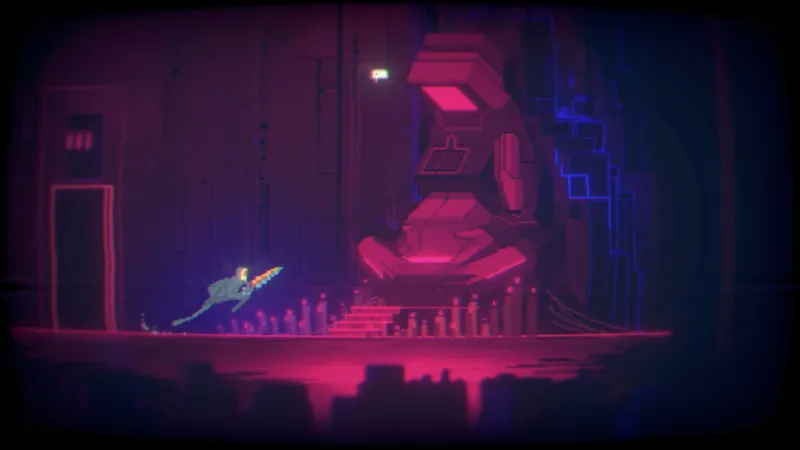

Sadly, there are one too many cases of this in Narita Boy and while some of the visual accompaniments have their moments, it’s nowhere near enough to excuse a game that at times feels like it’s completely misconstrued a sub-genre’s entire design philosophy. Not even its occasional platforming can make up for how barren and overstretched these segments can be. Running back and forth between distant locales, without providing much to compensate aside from a quaint vista or two in the backdrop. It’s not good when a game like this is clearly using such things as locked doors and distant keys to acquire just to pad out its run-time. Back-tracking is all well and good providing the journey there and the exploration that underpins it provides both intrigue and enjoyment with what we find. You like Metroidvanias? Well we’re one of those too - that’s good enough, right? Don’t look too close, the game seems to suggest. But there’s times that feel that Narita Boy is trying so desperately to ride on the goodwill of a sub-genre like Metroidvania, or even the more-broader action-adventure staple, so as to make up for its sparse and at times shallow progression. And not just through a general lack of any real originality (though that’s one of the main gripes) or at the very least an attempt to add to the bevvy of more interesting ideas sprouting up in the past few years from games of much better pedigree. Take that away though and the game is a litter of short-comings that ultimately sully what goodwill its aesthetic brings. One that at its best, offers a splendid array of pixel art and color usage that ties nicely into the grander, encompassing ’80s setting. Studio Koba can’t be faulted for giving their Digital Kingdom a touch of awe and eery mystery about its vast plains and at one point, a grandiose city to end proceedings on.Īgain, it’s the kind of indulgence Narita Boy is fortunately granted. On a pure artistic stand-point, Narita Boy has it in itself to wow and impresses with its painstaking dedication.

Not least the finer detail with its pixel art and occasional character/model design. One that for all its on-the-nose references to computers and lingo that can’t seem to go five minutes without mentioning the word “code” or its equivalent, still makes the journey worth it in brief spots of spectacle. And yes, there’s a spot of delight to share at the spectacle Studio Koba put before you with the team’s world design. There’s subtle puzzle-solving that doesn’t always spell it out for you, which is nice. Yes there are branching paths which may or may not lead to an optional collectible. Yes there’s back-tracking, yes there are items and upgrades to acquire that unlock new routes. Or perhaps to put it more bluntly, it’s not an entirely good or exciting Metroidvania. The sad truth being that beyond its visuals, its quainter, ambient approach to ’80s synthesizer music - likably-cheesy opening and closing themes aside - and a couple of tense boss encounters, there’s nothing here to proclaim as unique in its own right.įirst and foremost, Narita Boy isn’t a Metroidvania. But as it turns out, it’s only one of a handful of aspects Narita Boy has going for it. Not because it grants Studio Koba an open goal to secure their own stab at a somewhat comical, self-indulgent foray into action-adventure antics. That acknowledgment, that level of dignity - on how overblown and excessive current time’s obsession with ’80s culture has become - is much appreciated in a game like Narita Boy. Yet, thankfully, one that is at least aware of how dumb such an obsession may look to an outsider.

Much like its primary ’80s visual style, the imagery posed feels more so a loving indulgence in that particular culture. There’s no surprising gameplay depth or some fourth-wall breaking, left-field turn players can expect from out this brief seven/eight hour title. Even if Studio Koba’s game-within-a-game set-up - the idea that just maybe we the player may in fact be controlling someone else controlling the titular Narita Boy - is admittedly all surface-level. Narita Boy somehow finds a way to make such fractured visuals not only tolerable, but in a way effective at what it’s meaning to portray here. All manner of fog, bloom and letterboxing too, just as guilty. And further a field, the artistically-misled perception that a move away from clarity somehow heightens an aesthetic. I’ve got to give it to Studio Koba and Narita Boy for using what might be one of the most despised forms of post-processing - and generally one not many people would go out of their way to ensure is existent in a game of their choosing - namely Chromatic Aberration.


 0 kommentar(er)
0 kommentar(er)
